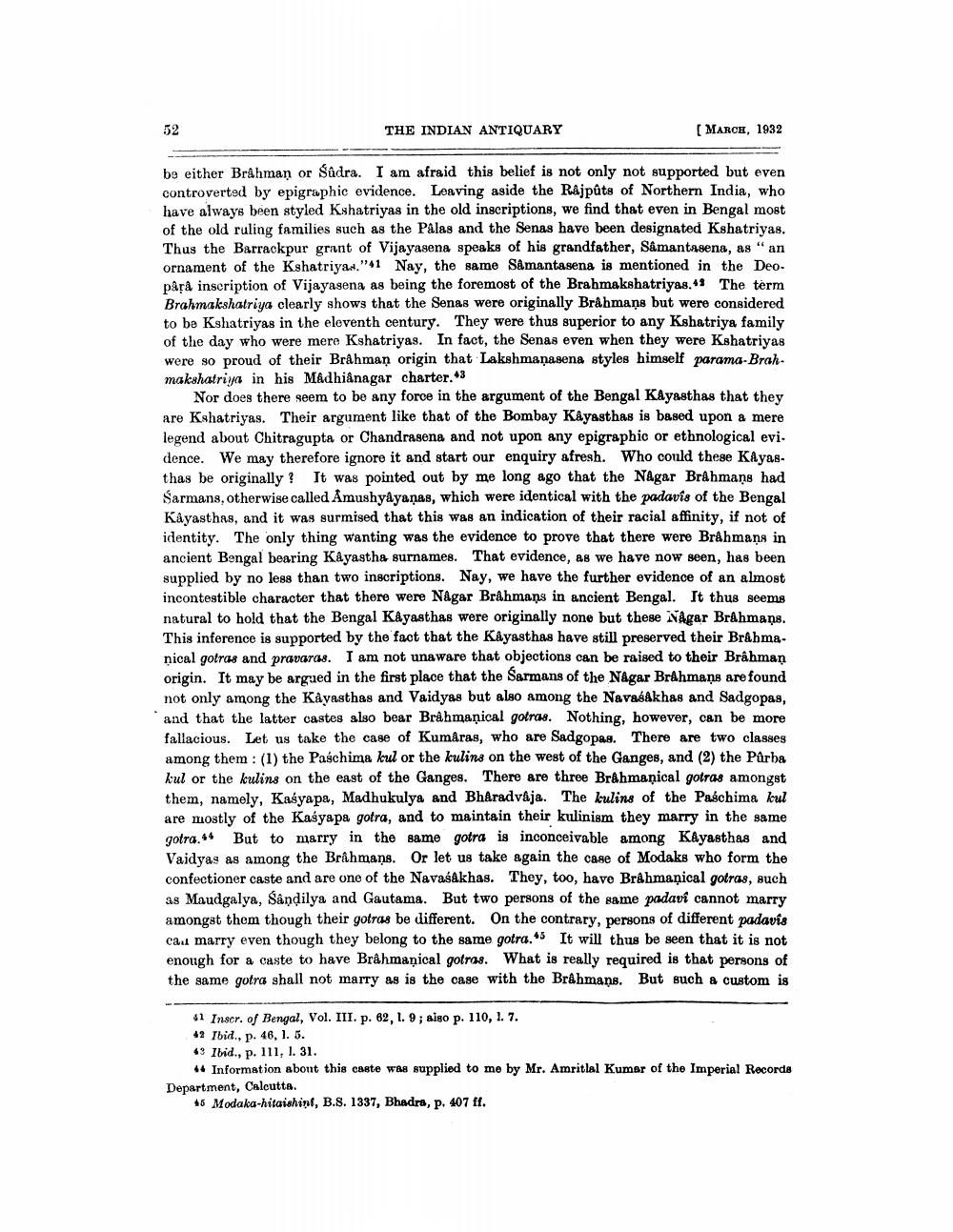________________
52
THE INDIAN ANTIQUARY
[MARCH, 1932
be either Brâhman or Sadra. I am afraid this belief is not only not supported but even controverted by epigraphic evidence. Leaving aside the Rajpûts of Northern India, who have always been styled Kshatriyas in the old inscriptions, we find that even in Bengal most of the old ruling families such as the Palas and the Senas have been designated Kshatriyas. Thus the Barrackpur grant of Vijayasena speaks of his grandfather, Samantasena, as "an ornament of the Kshatriyas."41 Nay, the same Såmantasena is mentioned in the Deopåra inscription of Vijayasena as being the foremost of the Brahmakshatriyas. The term Brahmakshatriya clearly shows that the Senas were originally Brahmane but were considered to be Kshatriyas in the eleventh century. They were thus superior to any Kshatriya family of the day who were mere Kshatriyas. In fact, the Senas even when they were Kshatriyas were so proud of their Brahman origin that Lakshmanasena styles himself parama-Brahmakshatriya in his Mâdhianagar charter. 43
Nor does there seem to be any force in the argument of the Bengal Kayasthas that they are Kshatriyas. Their argument like that of the Bombay Kayasthas is based upon a mere legend about Chitragupta or Chandrasena and not upon any epigraphic or ethnological evi. dence. We may therefore ignore it and start our enquiry afresh. Who could these Kiyas. thas be originally? It was pointed out by me long ago that the Nagar Brahmans had Sarmans, otherwise called Amushyâyaņas, which were identical with the padavís of the Bengal Kavasthag, and it was surmised that this was an indication of their racial affinity, if not of identity. The only thing wanting was the evidence to prove that there were Brâhmans in ancient Bengal bearing Kayastha surnames. That evidence, as we have now seen, has been supplied by no less than two inscriptions. Nay, we have the further evidence of an almost incontestible character that there were Någar Bråhmaņs in ancient Bengal. It thus seems natural to hold that the Bengal Kayasthas were originally none but these Nagar Brahmans. This inference is supported by the fact that the Kayasthas have still preserved their Brahma. nical gotras and pravaras. I am not unaware that objections can be raised to their Brahman origin. It may be argued in the first place that the Sarmans of the Någar Brahmans are found not only among the Kayasthas and Vaidyas but also among the Navasákhas and Sadgopas, and that the latter castes also bear Bråhmaṇical gotras. Nothing, however, can be more fallacious. Let us take the case of Kumâras, who are Sadgopas. There are two classes among them : (1) the Paschima kul or the kulins on the west of the Ganges, and (2) the Pûrba kul or the kulins on the east of the Ganges. There are three Brahmaņical gotras amongst them, namely, Kaśyapa, Madhukulya and Bharadvaja. The kulins of the Paschima kul are mostly of the Kaśyapa gotra, and to maintain their kulinism they marry in the same gotra 44 But to marry in the same gotra is inconceivable among Kayasthas and Vaidyas as among the Brahmans. Or let us take again the case of Modaks who form the confectioner caste and are one of the NavaśAkhas. They, too, havo Brahmanical gotras, such as Maudgalya, Sandilya and Gautama. But two persons of the same padavi cannot marry amongst them though their gotras be different. On the contrary, persons of different padavis cau marry even though they belong to the same gotra." It will thus be seen that it is not enough for a caste to have Brâhmaņical gotras. What is really required is that persons of the same gotra shall not marry as is the case with the Brahmans. But such a custom is
41 Inscr. of Bengal, Vol. III. p. 62, L. 9; aiso p. 110, 1. 7. 42 Ibid., p. 46, 1. 5. 49 Ibid., p. 111, 1. 31.
44 Information abont this caste was supplied to me by Mr. Amritlal Kumar of the Imperial Records Department, Calcutta.
15 Modaka-hitaishint, B.S. 1337, Bhadra, p. 407 ff.




